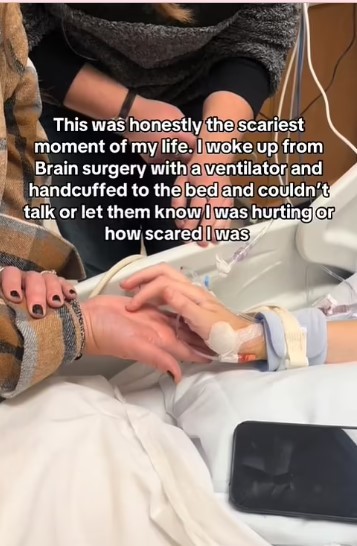Fabulous
TikToker Kaitlyn Jenkins Wakes Up From Surgery Handcuffed
TikToker Wakes Up Handcuffed After Surgery in Terrifying Moment.

A 21-year-old TikToker has shared a harrowing experience after waking up from life-saving brain surgery handcuffed and unable to speak, leaving her feeling trapped in what she described as a "living nightmare."
Kaitlyn Jenkins' Shocking Post-Surgery Experience
Kaitlyn Jenkins, a beauty entrepreneur from Texas, has been battling multiple rare disorders affecting her brain and spine. After undergoing a complex craniocervical fusion surgery to stabilize her skull and relieve chronic pain, she was horrified to wake up restrained and unable to communicate.
In a viral TikTok video, Jenkins shared footage of the distressing moment when she regained consciousness with her hands bound and a ventilator preventing her from speaking. Speaking to People magazine, she recalled her sheer terror:
“I was absolutely terrified — it felt like I was trapped in a living nightmare. I couldn’t understand why I couldn’t talk, and not knowing what was happening made everything feel even more surreal.”
Why Was She Restrained?
According to Jenkins, her medical team had mentioned the possibility of waking up with a ventilator during her pre-surgery consultation. However, she claims they failed to inform her about being physically restrained.
“The anesthesiologist quickly mentioned I might wake up with a ventilator, but they didn’t go into detail or mention handcuffs. I wish the hospital had a better system for patients to communicate when they’re on a ventilator and restrained,” she said.
Jenkins resorted to tracing letters on her mother’s hand to communicate her needs during the traumatic post-surgery period.

A Rare and Painful Medical Battle
Jenkins suffers from a combination of rare conditions, including:
Due to these conditions, Jenkins has undergone multiple surgeries throughout her life in an attempt to alleviate chronic pain and prevent further complications.
The Life-Altering Surgery
After extensive research, Jenkins found a neurosurgeon in New York who specialized in her conditions. The doctor recommended craniocervical fusion surgery—a procedure that fuses the skull and upper spine using metal plates, rods, and screws. This operation aims to stabilize the spine and reduce pain, offering Jenkins a potential breakthrough in her long-standing medical struggle.
While the surgery was deemed a success, the way she was treated in its aftermath left her feeling deeply unsettled.
“None of my previous brain surgeries involved restraint, so waking up that way was shocking,” she said.
A Long Road to Recovery
Following the surgery, Jenkins faced severe complications, including:
Due to these setbacks, she spent six weeks in the hospital. Learning to walk again proved difficult, as her frequent fainting spells posed additional risks.
“Re-learning to walk was already challenging, but frequent episodes of passing out made it even harder,” she said.
By late February, she was finally able to walk again, though she still relies on a walker for stability. Her recovery includes intensive physical and occupational therapy three times a week, along with the use of a bone growth stimulator for four hours daily to speed up bone fusion.
Emotional Impact and Patient Advocacy
Beyond the physical challenges, Jenkins described the emotional toll of her experience.
“It’s not just a physical recovery; there’s a mental and emotional recovery that takes time, too. This experience has changed my perspective on surgery and medical procedures.”
She now advocates for improved patient communication, especially for those undergoing major surgeries that require post-operative ventilation and restraints.
“I try to focus on the progress I’m making, but it’s hard not to think about how things might have been different without the complications. More than anything, I just want hospitals to have better systems in place so that no one else has to go through this feeling of helplessness.”

A Viral Story That Resonates
Jenkins’ story has sparked widespread discussion online, with many patients sharing similar experiences of waking up from surgery restrained or unable to communicate. Her viral TikTok video continues to gain attention, bringing awareness to the importance of patient consent and proper post-operative care.
As she continues her journey to recovery, Jenkins remains committed to raising awareness about rare disorders and advocating for better medical practices. Her story serves as a reminder of the importance of patient-centered care and the need for greater transparency in medical procedures.
Nerve Pain and Blackouts: Episodes that caused her to faint unexpectedly, making mobility even more challenging.
Osteolysis: The breakdown of bone tissue, a condition that can significantly delay healing.
Ehlers-Danlos Syndrome (EDS): A connective tissue disorder that weakens joints, skin, and blood vessels.
Craniocervical Instability: A condition where the ligaments that support the skull and spine are too loose.
Chiari Malformation Type 1: A disorder where part of the brain bulges through an opening at the base of the skull.

Jennifer Lopez looks ageless in a towel in no-makeup video

Amanda Holden spanks her derriere and thanks Spanx

Amanda Holden shows off more than bargained as she dances around in her outfit of the day

Italian models Giulia Salemi and Dayane Mello looks glam

Meet Harley Cameron, the stunning model who went from a BKFC ring girl to become a pro wrestler and found love

GreenGirlBella, Rocks Emirates Stadium in Painted Home Kit

Amanda Holden calls herself a 'good girl' in white dress with 'cheeky' split

Mum slammed by parents after flashing thong in school run outfit

Lottie Moss makes jaws dropp as she shows off her flawless body








Comments
Written news comments are in no way https://www.showbizglow.com it does not reflect the opinions and thoughts of. Comments are binding on the person who wrote them.